2022-2023学年牛津上海版七年级英语上册语法总结课件(共34张PPT)
文档属性
| 名称 | 2022-2023学年牛津上海版七年级英语上册语法总结课件(共34张PPT) | 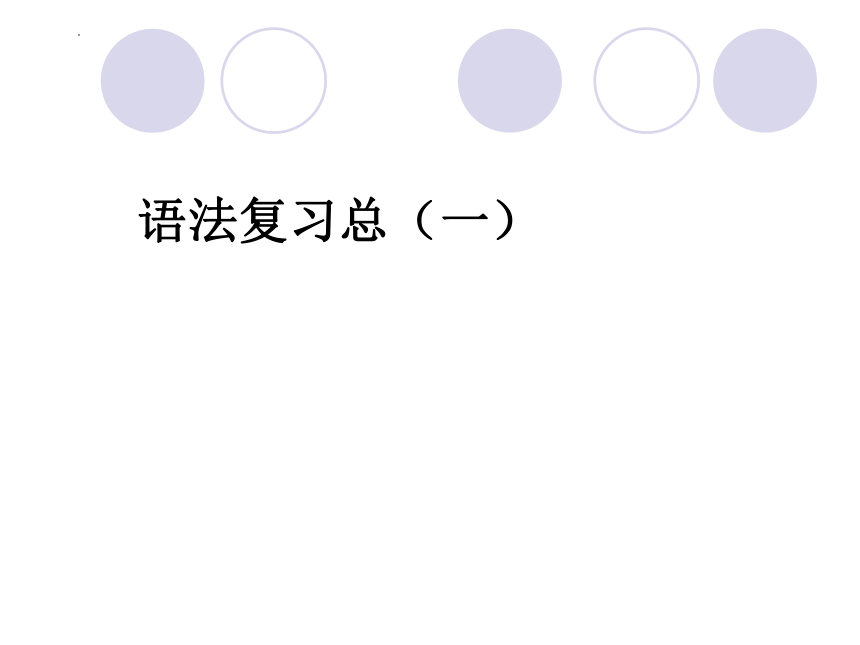 | |
| 格式 | zip | ||
| 文件大小 | 114.9KB | ||
| 资源类型 | 教案 | ||
| 版本资源 | 牛津上海版(试用本) | ||
| 科目 | 英语 | ||
| 更新时间 | 2022-08-07 10:55:41 | ||
图片预览

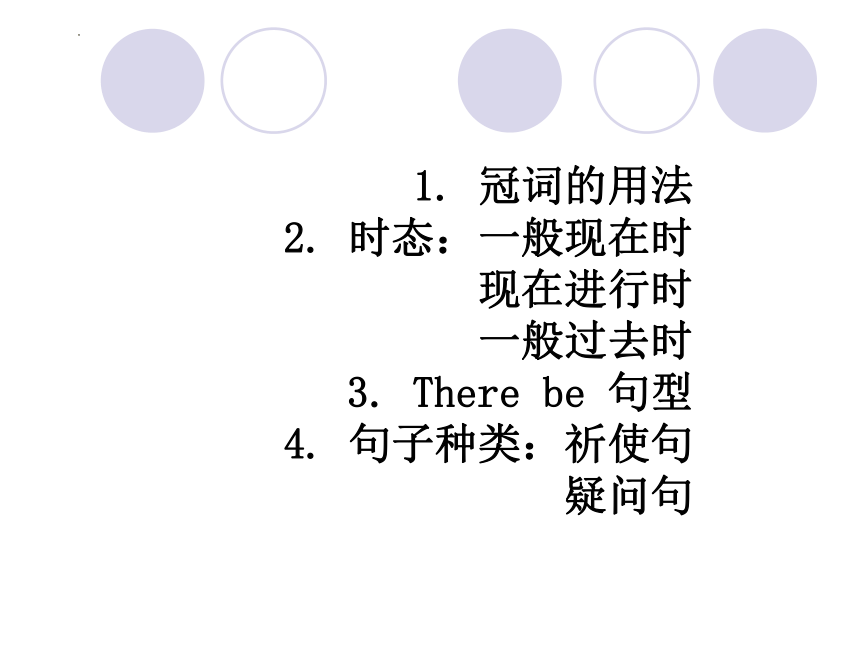
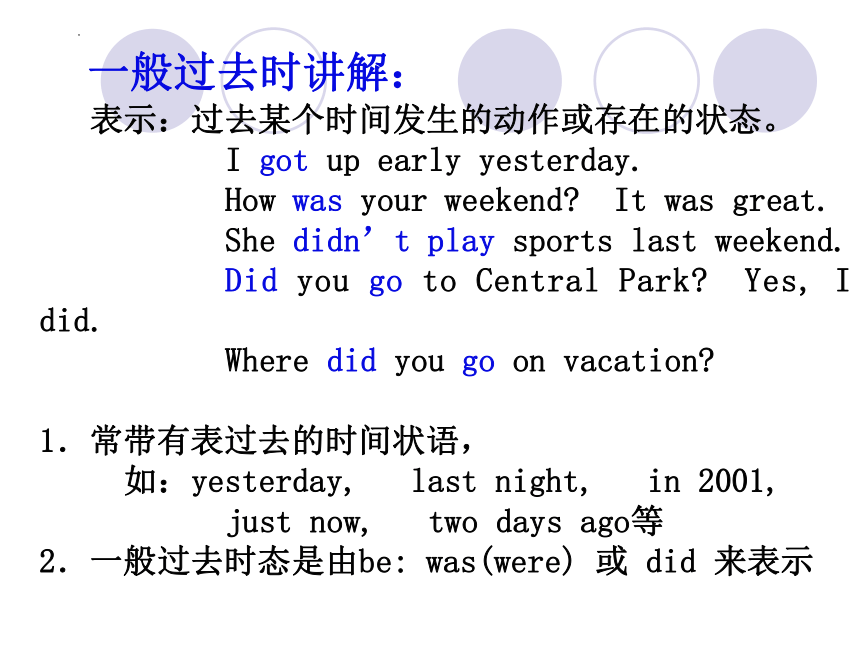
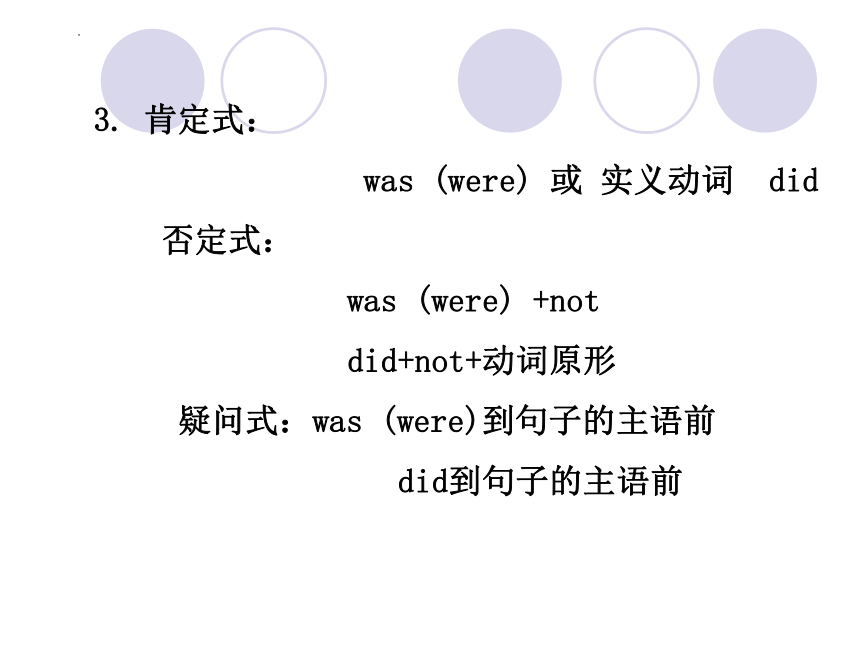
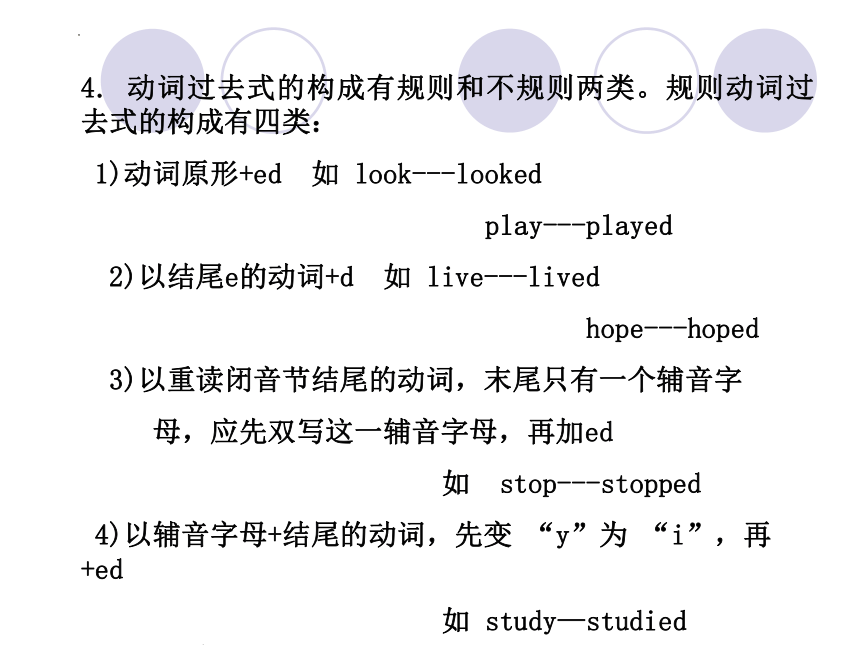
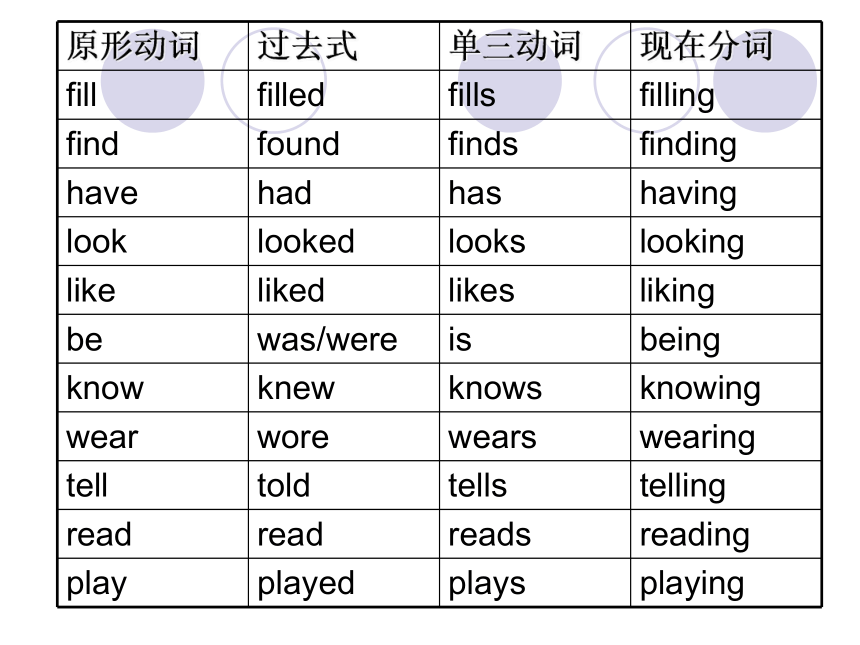

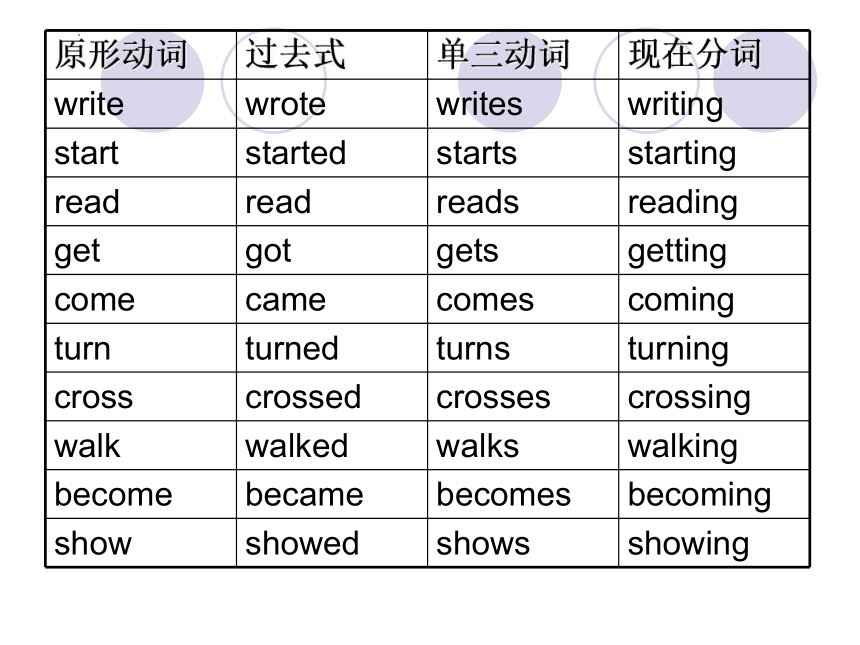
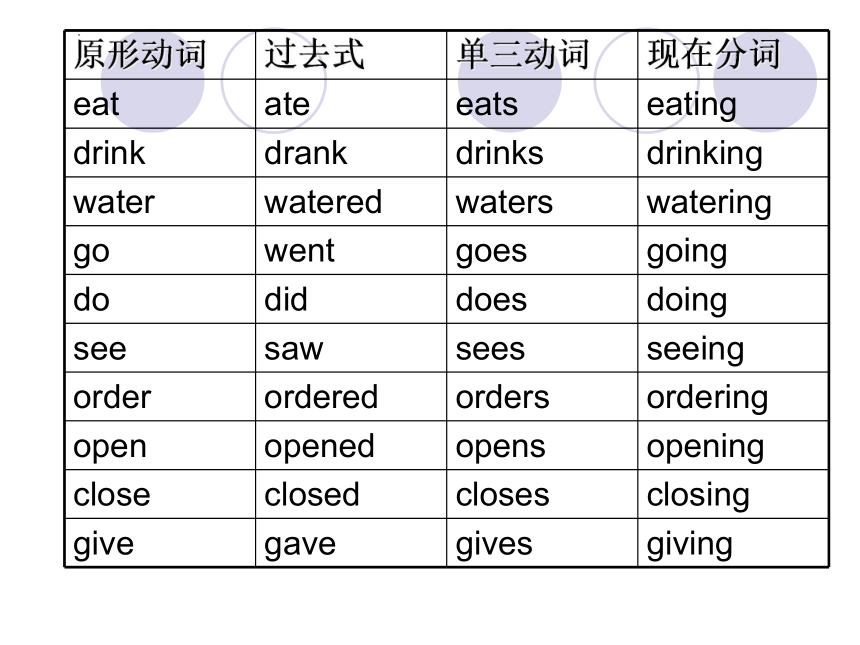

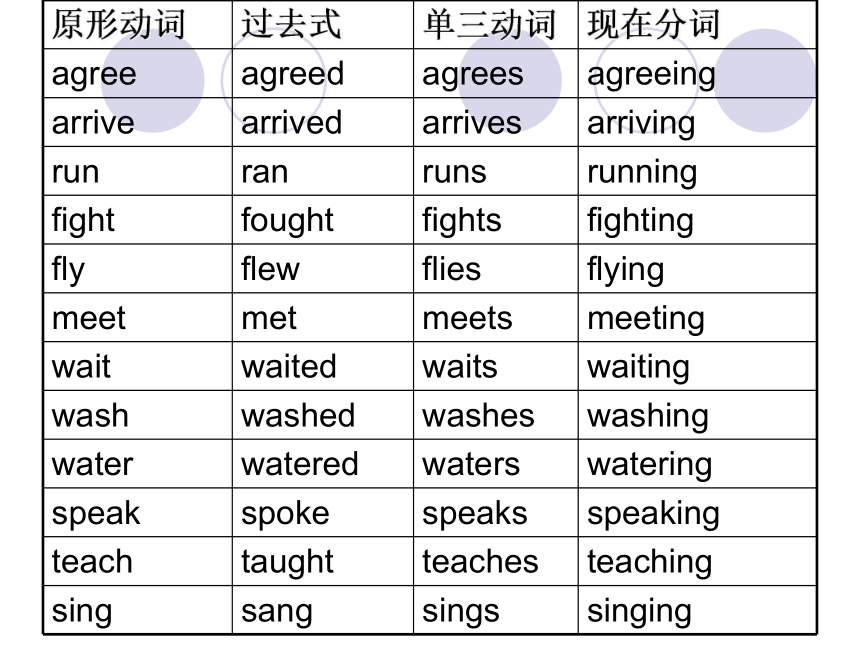
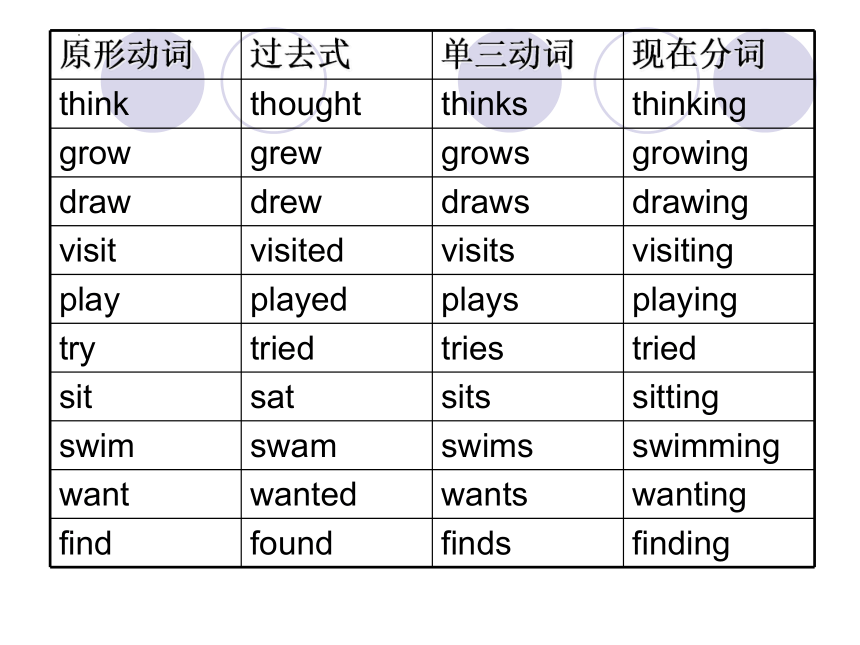
文档简介
(共34张PPT)
语法复习总(一)
1. 冠词的用法
2. 时态:一般现在时
现在进行时
一般过去时
3. There be 句型
4. 句子种类:祈使句
疑问句
一般过去时讲解:
表示:过去某个时间发生的动作或存在的状态。
I got up early yesterday.
How was your weekend It was great.
She didn’t play sports last weekend.
Did you go to Central Park Yes, I did.
Where did you go on vacation
1.常带有表过去的时间状语,
如:yesterday, last night, in 2001,
just now, two days ago等
2.一般过去时态是由be: was(were) 或 did 来表示
3. 肯定式:
was (were) 或 实义动词 did
否定式:
was (were) +not
did+not+动词原形
疑问式:was (were)到句子的主语前
did到句子的主语前
4. 动词过去式的构成有规则和不规则两类。规则动词过去式的构成有四类:
1)动词原形+ed 如 look---looked
play---played
2)以结尾e的动词+d 如 live---lived
hope---hoped
3)以重读闭音节结尾的动词,末尾只有一个辅音字
母,应先双写这一辅音字母,再加ed
如 stop---stopped
4)以辅音字母+结尾的动词,先变 “y”为 “i”,再+ed
如 study—studied cry---crie
原形动词 过去式 单三动词 现在分词
fill filled fills filling
find found finds finding
have had has having
look looked looks looking
like liked likes liking
be was/were is being
know knew knows knowing
wear wore wears wearing
tell told tells telling
read read reads reading
play played plays playing
原形动词 过去式 单三动词 现在分词
stop stopped stops stopping
talk talked talks talking
remember remembered remembers remembering
shop shopped shops shopping
begin began begins beginning
take took takes taking
forget forgot forgets forgetting
help helped helps helping
wash washed washes washing
watch watched watches watching
原形动词 过去式 单三动词 现在分词
write wrote writes writing
start started starts starting
read read reads reading
get got gets getting
come came comes coming
turn turned turns turning
cross crossed crosses crossing
walk walked walks walking
become became becomes becoming
show showed shows showing
原形动词 过去式 单三动词 现在分词
eat ate eats eating
drink drank drinks drinking
water watered waters watering
go went goes going
do did does doing
see saw sees seeing
order ordered orders ordering
open opened opens opening
close closed closes closing
give gave gives giving
原形动词 过去式 单三动词 现在分词
keep kept keeps keeping
sleep slept sleeps sleeping
spend spent spends spending
send sent sends sending
take took takes taking
stay stayed stays staying
say said says saying
study studied studies studying
buy bought buys buying
learn learned learns learning
practice practiced practices practicing
原形动词 过去式 单三动词 现在分词
agree agreed agrees agreeing
arrive arrived arrives arriving
run ran runs running
fight fought fights fighting
fly flew flies flying
meet met meets meeting
wait waited waits waiting
wash washed washes washing
water watered waters watering
speak spoke speaks speaking
teach taught teaches teaching
sing sang sings singing
原形动词 过去式 单三动词 现在分词
think thought thinks thinking
grow grew grows growing
draw drew draws drawing
visit visited visits visiting
play played plays playing
try tried tries tried
sit sat sits sitting
swim swam swims swimming
want wanted wants wanting
find found finds finding
原形动词 过去式 单三动词 现在分词
hear heard hears hearing
listen listened listens listening
travel traveled travels traveling
cry cried cries crying
walk walked walks walking
decide decided decides deciding
bring brought brings bringing
rain rained rains raining
snow snowed snows snowing
get got gets getting
原形动词 过去式 单三动词 现在分词
ask asked asks asking
answer answered answers answering
discuss discussed discusses discussing
mind minded minds minding
join joined joins joining
tell told tells telling
lie lay lies lying
die died dies dying
enjoy enjoyed enjoys enjoying
show showed shows showing
原形动词 过去式 单三动词 现在分词
pass passed passes passing
relax relaxed relaxes relaxing
live lived lives living
feel felt feels feeling
work worked works working
build built builds building
cook cooked cooks cooking
make made makes making
put put puts putting
stand stood stands standing
leave left leaves leaving
clean cleaned cleans cleaning
写作翻译范文:
乡村之旅
星期天,天气晴朗,还很凉快。妈妈让我带着我的小弟弟到乡下去玩。她告诉我要好好照顾他。我们沿着公路走,阳光灿烂,微风拂面。我们看见花儿在向我们微笑,我们听到了鸟儿在枝头歌唱。这幅景象真得非常的美丽。当我们感到累的时候,我们就回家了。我们看见我们的妈妈正在门口等我们。
祈使句的复习建议:
掌握祈使句的基本用法和基本形式:
1) 省略第二人称主语 you.
2) 祈使句的肯定形式:Do/Be 开头;
否定祈使句: Don’ t do / Don’ t be开头
3) 为表示礼貌,祈使句前或句末可加please.
句末用please时,please前用“,”隔开。
祈使句的基本含义:
表示请求、命令、劝说、号召、警告等。
1.Turn left on First Avenue and enjoy the
city’s quiet streets and small parks
2. Don’t be late for school.
3. Please write and tell me about yourself.
4. Be quiet.
5. Come in, please.
6. Let me tell you the way to my house.
祈使句的复习方法:
教师设计将陈述句改写成祈使句的练习,强化祈使句的基本句型结构。
作连词成句的练习,使学生明确祈使句省略主语和动词原形开头的基本构成形式。
练习写家规,校规的作文,将祈使句的用法应用到篇章之中。
There be 句型结构复习建议:
复习的层次:
1. be动词与后面名词单复数一致的问题
2. There be 句型结构与have/has的区别
3. There be 句型结构的就近原则
There be 的一般现在时结构
某地有某物/某时有某事
There is a bank near here.
There are many people here on vacation.
There isn’t a pay phone across from the bank.
Is there a big supermarket near your house
There be 句型结构讲解:
1.句子中的be和后面所跟的名词在数方面必须一致。
2. There be 的肯定式:There be (is/are)
否定式: There isn’t
There aren’t
疑问式:is/are 提到there的前面
一般疑问句的回答:Yes, there is/are.
No, there isn’t / aren’t.
特殊问句的回答:There is/are
现在进行时讲解:
表示: 说话瞬间或现阶段正在进的动作。(时态可以通过动词的变化形式来表示)
I am watching TV.
The students are studying for the exams.
She isn’t writing a letter now
Is Nancy doing her homework
What are you doing now
1.现在进行时时态构成:
助动词be (am, is, are)+ doing
2.肯定式:
be (am, is, are) + doing
3.否定式:
be (am, is, are) +not +doing
4.一般疑问句构成:
将be与主语互换位置
5. 特殊疑问句
What(疑问词)+ be+主语+doing
6.进行时的提示词。
如:now, these days,look, listen,
It’s …o’clock等
7. 现在分词的四种构成形式:
1) 动词原形+ing.
如:go---going
do---doing
2) e结尾的动词,先去e再加ing
如:write---writing
take ---taking
3) 以重读闭音节结尾的动词,末尾只有一个辅音字母,应先双写这一辅音字母,再加ing.
如: sit—sitting
run---running
begin---beginning
4)以ie结尾的动词先变ie为y, 再+ing.
如: lie---lying
die----dying
冠 词
1. 不定冠词a / an 的基本用法:
1) 泛指某人或某物 。如
Then an idea occurred to me.
2) 代表一类人或物,但没有one强烈 。
An elephant is heavier than a horse .
3) 用于某些词组或成语中。
As a matter of fact , I don’t like the story.
2. 不定冠词a /an 的位置:
a / an 除了位于名词短语之首之外,还有几种特例:
当名词短语中含有so,as,too,how 这样的词时, a /an 的位置为: so/ as / too / how + adj + a (an )+名词
eg. so nice a girl
b) such (what )+ a(an) +adj +名词
eg. such a nice girl
c) quite (rather)+ a (an) +adj +名词 = a quite(rather) + adj + 名词
4. 定冠词the 的基本用法
1) 特指人或物
Show me the photo of your family.
Cut a tomato. Put the tomato on the bread.
( 指前面提到过的事物)
How much are the red socks (双方都知道)
2) 用在单数名词前表示一类人或物
The dog is a useful animal .
3) 用在序数词和形容词最高级前
In the first photo, I’m playing basketball.
What’s the best radio station
4) 用在乐器名称前。
None of them can play the piano.
用在姓氏的复数形式前。
the Taylors. (泰勒一家人)
6)用在固定词组中 in the morning
all the same
5. 零冠词 的惯用法:
在季节、月份、 星期、 节假日、学科、三餐、
球、棋类名词前。
2) 在称呼语、独一无二的头衔、职位的名词前。
I like my music teacher, Mr Cooper.
3) 在国名、城市名、人名、语言等名词前。
4) 在专用名词(汉语拼音)开头的名词词组前。
Beijing airport Tian’an men Square
5) 表乘交通工具的短语中
by bus = on a bus,
by train = on the/a train
疑问句
一般疑问句:指须用yes或no回答的问句。
一般现在时:1)Am/Is/Are + 主语……
2) Do+主语+do….
3) Does+主语+do….
4) Can+主语+ do….
现在进行时:Am/Is/Are+主语+ doing…
一般过去时:1) Was/Were + 主语……
2)Did +主语+ do……
特殊疑问句:
指以who, what, where, when, how等疑问词+ 一般疑问句语序的问句。
语法复习总(一)
1. 冠词的用法
2. 时态:一般现在时
现在进行时
一般过去时
3. There be 句型
4. 句子种类:祈使句
疑问句
一般过去时讲解:
表示:过去某个时间发生的动作或存在的状态。
I got up early yesterday.
How was your weekend It was great.
She didn’t play sports last weekend.
Did you go to Central Park Yes, I did.
Where did you go on vacation
1.常带有表过去的时间状语,
如:yesterday, last night, in 2001,
just now, two days ago等
2.一般过去时态是由be: was(were) 或 did 来表示
3. 肯定式:
was (were) 或 实义动词 did
否定式:
was (were) +not
did+not+动词原形
疑问式:was (were)到句子的主语前
did到句子的主语前
4. 动词过去式的构成有规则和不规则两类。规则动词过去式的构成有四类:
1)动词原形+ed 如 look---looked
play---played
2)以结尾e的动词+d 如 live---lived
hope---hoped
3)以重读闭音节结尾的动词,末尾只有一个辅音字
母,应先双写这一辅音字母,再加ed
如 stop---stopped
4)以辅音字母+结尾的动词,先变 “y”为 “i”,再+ed
如 study—studied cry---crie
原形动词 过去式 单三动词 现在分词
fill filled fills filling
find found finds finding
have had has having
look looked looks looking
like liked likes liking
be was/were is being
know knew knows knowing
wear wore wears wearing
tell told tells telling
read read reads reading
play played plays playing
原形动词 过去式 单三动词 现在分词
stop stopped stops stopping
talk talked talks talking
remember remembered remembers remembering
shop shopped shops shopping
begin began begins beginning
take took takes taking
forget forgot forgets forgetting
help helped helps helping
wash washed washes washing
watch watched watches watching
原形动词 过去式 单三动词 现在分词
write wrote writes writing
start started starts starting
read read reads reading
get got gets getting
come came comes coming
turn turned turns turning
cross crossed crosses crossing
walk walked walks walking
become became becomes becoming
show showed shows showing
原形动词 过去式 单三动词 现在分词
eat ate eats eating
drink drank drinks drinking
water watered waters watering
go went goes going
do did does doing
see saw sees seeing
order ordered orders ordering
open opened opens opening
close closed closes closing
give gave gives giving
原形动词 过去式 单三动词 现在分词
keep kept keeps keeping
sleep slept sleeps sleeping
spend spent spends spending
send sent sends sending
take took takes taking
stay stayed stays staying
say said says saying
study studied studies studying
buy bought buys buying
learn learned learns learning
practice practiced practices practicing
原形动词 过去式 单三动词 现在分词
agree agreed agrees agreeing
arrive arrived arrives arriving
run ran runs running
fight fought fights fighting
fly flew flies flying
meet met meets meeting
wait waited waits waiting
wash washed washes washing
water watered waters watering
speak spoke speaks speaking
teach taught teaches teaching
sing sang sings singing
原形动词 过去式 单三动词 现在分词
think thought thinks thinking
grow grew grows growing
draw drew draws drawing
visit visited visits visiting
play played plays playing
try tried tries tried
sit sat sits sitting
swim swam swims swimming
want wanted wants wanting
find found finds finding
原形动词 过去式 单三动词 现在分词
hear heard hears hearing
listen listened listens listening
travel traveled travels traveling
cry cried cries crying
walk walked walks walking
decide decided decides deciding
bring brought brings bringing
rain rained rains raining
snow snowed snows snowing
get got gets getting
原形动词 过去式 单三动词 现在分词
ask asked asks asking
answer answered answers answering
discuss discussed discusses discussing
mind minded minds minding
join joined joins joining
tell told tells telling
lie lay lies lying
die died dies dying
enjoy enjoyed enjoys enjoying
show showed shows showing
原形动词 过去式 单三动词 现在分词
pass passed passes passing
relax relaxed relaxes relaxing
live lived lives living
feel felt feels feeling
work worked works working
build built builds building
cook cooked cooks cooking
make made makes making
put put puts putting
stand stood stands standing
leave left leaves leaving
clean cleaned cleans cleaning
写作翻译范文:
乡村之旅
星期天,天气晴朗,还很凉快。妈妈让我带着我的小弟弟到乡下去玩。她告诉我要好好照顾他。我们沿着公路走,阳光灿烂,微风拂面。我们看见花儿在向我们微笑,我们听到了鸟儿在枝头歌唱。这幅景象真得非常的美丽。当我们感到累的时候,我们就回家了。我们看见我们的妈妈正在门口等我们。
祈使句的复习建议:
掌握祈使句的基本用法和基本形式:
1) 省略第二人称主语 you.
2) 祈使句的肯定形式:Do/Be 开头;
否定祈使句: Don’ t do / Don’ t be开头
3) 为表示礼貌,祈使句前或句末可加please.
句末用please时,please前用“,”隔开。
祈使句的基本含义:
表示请求、命令、劝说、号召、警告等。
1.Turn left on First Avenue and enjoy the
city’s quiet streets and small parks
2. Don’t be late for school.
3. Please write and tell me about yourself.
4. Be quiet.
5. Come in, please.
6. Let me tell you the way to my house.
祈使句的复习方法:
教师设计将陈述句改写成祈使句的练习,强化祈使句的基本句型结构。
作连词成句的练习,使学生明确祈使句省略主语和动词原形开头的基本构成形式。
练习写家规,校规的作文,将祈使句的用法应用到篇章之中。
There be 句型结构复习建议:
复习的层次:
1. be动词与后面名词单复数一致的问题
2. There be 句型结构与have/has的区别
3. There be 句型结构的就近原则
There be 的一般现在时结构
某地有某物/某时有某事
There is a bank near here.
There are many people here on vacation.
There isn’t a pay phone across from the bank.
Is there a big supermarket near your house
There be 句型结构讲解:
1.句子中的be和后面所跟的名词在数方面必须一致。
2. There be 的肯定式:There be (is/are)
否定式: There isn’t
There aren’t
疑问式:is/are 提到there的前面
一般疑问句的回答:Yes, there is/are.
No, there isn’t / aren’t.
特殊问句的回答:There is/are
现在进行时讲解:
表示: 说话瞬间或现阶段正在进的动作。(时态可以通过动词的变化形式来表示)
I am watching TV.
The students are studying for the exams.
She isn’t writing a letter now
Is Nancy doing her homework
What are you doing now
1.现在进行时时态构成:
助动词be (am, is, are)+ doing
2.肯定式:
be (am, is, are) + doing
3.否定式:
be (am, is, are) +not +doing
4.一般疑问句构成:
将be与主语互换位置
5. 特殊疑问句
What(疑问词)+ be+主语+doing
6.进行时的提示词。
如:now, these days,look, listen,
It’s …o’clock等
7. 现在分词的四种构成形式:
1) 动词原形+ing.
如:go---going
do---doing
2) e结尾的动词,先去e再加ing
如:write---writing
take ---taking
3) 以重读闭音节结尾的动词,末尾只有一个辅音字母,应先双写这一辅音字母,再加ing.
如: sit—sitting
run---running
begin---beginning
4)以ie结尾的动词先变ie为y, 再+ing.
如: lie---lying
die----dying
冠 词
1. 不定冠词a / an 的基本用法:
1) 泛指某人或某物 。如
Then an idea occurred to me.
2) 代表一类人或物,但没有one强烈 。
An elephant is heavier than a horse .
3) 用于某些词组或成语中。
As a matter of fact , I don’t like the story.
2. 不定冠词a /an 的位置:
a / an 除了位于名词短语之首之外,还有几种特例:
当名词短语中含有so,as,too,how 这样的词时, a /an 的位置为: so/ as / too / how + adj + a (an )+名词
eg. so nice a girl
b) such (what )+ a(an) +adj +名词
eg. such a nice girl
c) quite (rather)+ a (an) +adj +名词 = a quite(rather) + adj + 名词
4. 定冠词the 的基本用法
1) 特指人或物
Show me the photo of your family.
Cut a tomato. Put the tomato on the bread.
( 指前面提到过的事物)
How much are the red socks (双方都知道)
2) 用在单数名词前表示一类人或物
The dog is a useful animal .
3) 用在序数词和形容词最高级前
In the first photo, I’m playing basketball.
What’s the best radio station
4) 用在乐器名称前。
None of them can play the piano.
用在姓氏的复数形式前。
the Taylors. (泰勒一家人)
6)用在固定词组中 in the morning
all the same
5. 零冠词 的惯用法:
在季节、月份、 星期、 节假日、学科、三餐、
球、棋类名词前。
2) 在称呼语、独一无二的头衔、职位的名词前。
I like my music teacher, Mr Cooper.
3) 在国名、城市名、人名、语言等名词前。
4) 在专用名词(汉语拼音)开头的名词词组前。
Beijing airport Tian’an men Square
5) 表乘交通工具的短语中
by bus = on a bus,
by train = on the/a train
疑问句
一般疑问句:指须用yes或no回答的问句。
一般现在时:1)Am/Is/Are + 主语……
2) Do+主语+do….
3) Does+主语+do….
4) Can+主语+ do….
现在进行时:Am/Is/Are+主语+ doing…
一般过去时:1) Was/Were + 主语……
2)Did +主语+ do……
特殊疑问句:
指以who, what, where, when, how等疑问词+ 一般疑问句语序的问句。
同课章节目录
- Module 1 Relationships
- Unit 1 Relationships in beijing
- Unit 2 Our animal friends
- Unit 3 Friends from other countries
- Module 2 My Neighborhood
- Unit 4 Jobs people do
- Unit 5 Choosing a new flat
- Unit 6 Different places
- Unit 7 Signs around us
- Module 3 Diet and health
- Unit 8 Growing healthy,growing
- Unit 9 International Food Festival
- Unit 10 A birthday party
- Unit 11 My food project
